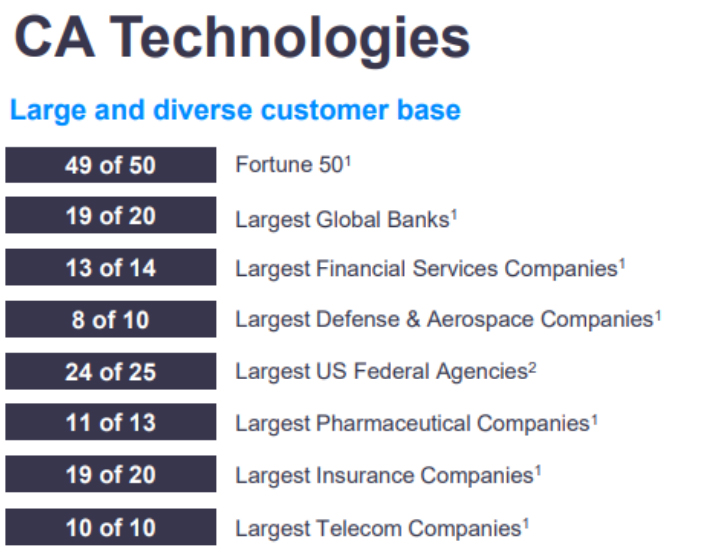With the acquisition of CA Technologies, Broadcom Corp Cl A (BRCM US) is sending a signal that the smartphone business has peaked. It also highlights the challenge associated with finding the next leg of the Company’s growth story, which in our view, met its end at the hands of CFIUS.
Broadcom Corp Cl A (BRCM US) (“Broadcom” or the “Company”) surprised equity markets by announcing a bid for CA Technologies (“CA”) after markets closed on July 11, 2018. If the aftermarket reaction of investors to the deal is any indication, few are cheering. After a down day in the markets, after hours the company lost approximately $6.8 Billion in market capitalization once investors got wind of the deal. We believe more downside is in the offing once markets resume trading Thursday.
The deal is confirmed subject to customary closing conditions and regulatory approvals, but as far as the board of directors is concerned, both boards have provided their approval. As per the press release issued by CA;
Under the terms of the agreement, which has been approved by the boards of directors of both companies, CA’s shareholders will receive $44.50 per share in cash. This represents a premium of approximately 20% to the closing price of CA common stock on July 11, 2018, the last trading day prior to the transaction announcement, and a premium of approximately 23% to CA’s volume-weighted average price (“VWAP”) for the last 30 trading days. The all-cash transaction represents an equity value of approximately $18.9 billion, and an enterprise value of approximately $18.4 billion.
Is the After-Market Reaction Overdone?
Although one can never be too sure based on an immediate reaction in the marketplace, it will difficult for Broadcom’s management to sugar coat this decision. To us, it is strategically challenged on multiple fronts.
- Broadcom is diversifying its revenue base from hardware to software
- Broadcom is expanding from a high growth semiconductor segment spanning consumer and enterprise into a slow-growth enterprise software segment
- Broadcom went from cutting-edge aspirations of 5G and buying one of the world’s premier technology companies with a dominant footprint across the globe including China, i.e. Qualcomm Inc (QCOM US), to buying one of the laggards of the mainframe computing segment
- With 70% of CA’s revenue domiciled in the U.S., Broadcom is increasing its commitment to the US economy when a slowdown driven by President Trump’s wayward policies towards international trade appears inevitable
Is CA any different from IBM?
Investors in the world overpay a premium for growth and future-proofing portfolio investments. That is the reason Netflix Inc (NFLX US) towers above the old-age behemoths of network-based broadcasting while telecom giants of yesteryear are market capitalization minnows compared to Facebook Inc A (FB US), which, by the way, is almost three times as valuable as Intl Business Machines Corp (IBM US). That brings us to CA which claims that it already serves the top echelon of the Fortune 500, as illustrated in Figure 1.
Figure 1 – What else is there to conquer?

Source: ANTYA Investments Inc. and CA Technologies
A simple look at Figure 1 illustrates that CA does not have room to grow in the large enterprise. Moreover, in our view Figure, 1 highlights multiple challenges in the offing or currently underway and being dealt with by CA.
Banks, Telecoms, Insurance, and Financial Services companies are facing dis-intermediation, Blockchain, intense competition, regulatory scrutiny and are under attack with industrial boundaries being redrawn by upstarts and challengers from all walks of life. Therefore, retrench, redesign and redeploy is the mantra amongst financial services and telecom players, and therefore,
price pressures and personnel shrink for 3rd party service providers are the norms.
President Trump’s desire to level the playing field for the American worker is redrawing the H1-B and L1 visa landscape, pressuring all old-age U.S. and foreign technology companies. We expect CA will face additional margin pressures from foreign worker retrenchments as well as higher labor costs given a tight economy for labor. Some of that is evident from the initiative announced by CA as part of its 2019 restructuring plan reproduced below.
On May 2, 2018, the Company’s Board of Directors approved a restructuring plan (“Fiscal 2019 Plan”) to better align its business priorities. The Fiscal 2019 Plan comprises the termination of approximately 800 employees and facility exits and consolidations. These actions are intended to better align the Company’s cost structure with the skills and resources required to more effectively pursue opportunities in the marketplace and execute the Company’s long-term growth strategy, which includes a particular focus on shifting more of the Company’s business to a subscription-based model. Actions under the Fiscal 2019 Plan are expected to be substantially completed by the end of fiscal 2019. Under the Fiscal 2019 Plan, the Company expects to incur a pre-tax charge between approximately $140 million and $160 million (including severance costs between approximately $90 million and $100 million and facility exit and consolidation costs between approximately $50 million and $60 million).
Evidently, CA is cognizant of the threat facing its business and is trying to preempt some of the EBITDA and EPS headwinds under the guise of a one-time restructuring charge to right-size the operations. Why would Broadcom want to own this mess, which is beyond our understanding? Previously we had said that Hock Tan showed up at Qualcomm’s door with nothing more than Chutzpah. For details see Broadcom Limited – Staring at Defeat.
In the case of the current bid, we believe Mr. Tan has thrown in the towel.
If Broadcom is not a Growth Stock then can it maintain its multiple?
With the CA acquisition, we believe Broadcom is telegraphing that:
- The smartphone business has peaked
- It is unlikely to be a leader in the 5G space
- Apple will invest and do more backward integration to increase it’s designed and manufactured content in its devices
- It is no longer a growth company
If all or some of this is true, it will be impossible to maintain a 13x EV/ EBITDA multiple going forward. The stock has a significant downside as growth-oriented investors exit their positions. Stay tuned!
We also believe that it is unlikely that the bid will be raised, or that shareholders can ask for more, given IBM’s valuation which is much lower than the multiple offered by the Company.

